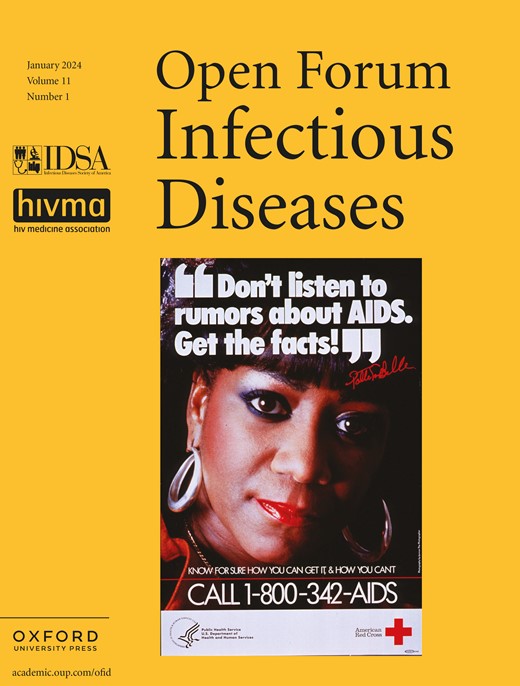
Cover image

Volume 11, Issue 1, January 2024
Review Articles
A Systematic Review of the Therapeutic Outcome of Mucormycosis
Untreated mucormycosis has a 100% mortality, reduced to ~32% with amphotericin B, ~14% with amphotericin B followed by azole (possible survivor bias), 17-25% with posaconazole or isavuconazole alone, or ~7% in combination with amphotericin B. Surgical resection(s) reduces mortality from ~67% to ~38%.
A Systematic Literature Review to Identify Diagnostic Gaps in Managing Immunocompromised Patients With Cancer and Suspected Infection
Antimicrobial Resistance
Brief Report
Antimicrobial Stewardship Teams in Veterans Affairs and Nonfederal Hospitals in the United States: A National Survey of Antimicrobial Stewardship Practices
Behavioral and Social Aspects of Infectious Diseases
Major Article
Feasibility and Acceptability of Human Immunodeficiency Virus Self-Testing for Men of Middle-to-Upper Socioeconomic Status in Botswana: A Pilot Study at 4 Worksites in the Financial Sector
Clinical Trials and Therapeutics
Major Articles
Healthcare Resource Utilization and Discharge Readiness in Adult Hospitalized Patients With Candidemia or Invasive Candidiasis Who Received an Echinocandin: An Analysis of United States Hospitals
Hospital costs of patients with invasive candidiasis who received an echinocandin were substantial and most required additional medical care postdischarge. Many patients (43%) on an echinocandin at hospital discharge were potentially dischargeable prior to their actual discharge day.
Very-Low-Level Viremia, Inflammatory Biomarkers, and Associated Baseline Variables: Three-Year Results of the Randomized TANGO Study
Switching to dolutegravir-lamivudine demonstrated durable noninferior efficacy, with similar effects on inflammation, versus continuing tenofovir alafenamide–based regimens over 3 years. Long-term inflammatory biomarker levels were low; comparable between treatment groups; and associated with demographic, lifestyle, and baseline disease characteristics.
COVID-19 Convalescent Plasma Therapy: Long-term Implications
Brief Report
Changes in Inflammatory Cytokines After Chronic Hepatitis C Treatment Among People Living With HIV
Diagnostic Methods and Tools
Major Articles
Effect of Antibiotic Administration Before Joint Aspiration on Synovial Fluid White Blood Cell Count in Native Joint Septic Arthritis
Antibiotic administration before joint aspiration for suspected septic arthritis appears to decrease synovial fluid white blood cell counts, percentages of polymorphonuclear cells, and rates of culture positivity. Efforts limiting preaspiration antibiotics are important to minimize diagnostic dilemmas and treatment delays.
Higher Sensitivity of Xpert MTB/RIF Ultra Over Tuberculosis Culture for the Diagnosis of Spinal Tuberculosis With Open or Computed Tomography–Guided Biopsies
Xpert MTB/RIF Ultra has a high diagnostic accuracy for spinal tuberculosis in both open and CT-guided biopsy samples, irrespective of HIV-1 coinfection, while tuberculosis culture has limited sensitivity when using CT-guided biopsies, particularly in patients on concurrent pulmonary tuberculosis treatment.
Diagnostic Accuracy of Clinical Diagnostic Scoring Systems for Childhood Tuberculosis: A Systematic Review and Meta-analysis
Applicability of Bronchoalveolar Lavage Fluid and Plasma Metagenomic Next-Generation Sequencing Assays in the Diagnosis of Pneumonia
Absence of Type I Interferon Autoantibodies or Significant Interferon Signature Alterations in Adults With Post–COVID-19 Syndrome
Model-Informed Precision Dosing Improves Outcomes in Patients Receiving Vancomycin for Gram-Positive Infections
Area under the curve (AUC)–guided vancomycin therapy via model-informed precision dosing using pre–steady state, single-concentration monitoring for culture-proven gram-positive infections was compared to those receiving trough-guided therapy using a desirability of outcome ranking analysis. More patients experienced the most desirable outcome with AUC-guided therapy.
Brief Report
Reflex Human Immunodeficiency Virus (HIV) Type 1 RNA Testing Enables Timely Differentiation of False-Positive Results From Acute HIV Infection
Education and Training in Infectious Diseases
Major Article
Curriculum and Competency Guidelines for the Advanced Care Practitioner in Infectious Disease
We have developed a curriculum and competency guidelines for Advanced Care Practitioners in Infectious Disease (ID). Our document provides the foundation for the full scope of ID practice with emphasis on clinical experience as the principal means of achieving competence.
Epidemiology and Disease Surveillance
Major Articles
Use of Rapid Antigen Triple Test Nasal Swabs (COVID-VIRO ALL-IN TRIPLEX: Severe Acute Respiratory Syndrome Coronavirus 2, Respiratory Syncytial Virus, and Influenza) in Children With Respiratory Symptoms: A Real-life Prospective Study
For 8329 children with flu-like illness (65.3%), bronchiolitis (17.9%), otitis (8.8%), and croup (6.3%), the use of a rapid antigen triple test to detect SARS-CoV-2, respiratory syncytial virus, and influenza led to a viral diagnosis in 47.9% of cases.
Disparities in Hypertension Prevalence, Awareness, Treatment, and Control Among Women Living With and Without HIV in the US South
Black women had a higher prevalence of hypertension when compared with White and Hispanic women. Additionally, treatment for hypertension is higher in women with HIV than women without HIV, which may result from greater access and engagement with medical care.
Reducing Initial Loss to Follow-up Among People With Bacteriologically Confirmed Tuberculosis: LINKEDin, a Quasi-experimental Study in South Africa
Burden of Medically Attended Diarrhea and Outpatient Clostridioides difficile Infection Among Persons in 2 Large Integrated Healthcare Settings, 2016–2021
A high incidence of outpatient Clostridioides difficile infection (CDI) was detected despite infrequent CDI testing among patients with medically attended diarrhea. The majority of those with outpatient CDI had no recent antibiotic use and no recent hospitalization.
Brief Reports
Not Only Meningitis but Also Epiglottitis: An Emerging Clinical Presentation of Invasive Meningococcal Disease
Country-Specific Screening, Prevalence, and Immunity Rates for Hepatitis B Infection in a Large US Safety-Net System
Global Health and Infectious Diseases
Major Article
Three Years of the Coronavirus Disease 2019 Pandemic in a European Region: A Population-Based Longitudinal Assessment in Madrid Between 2020 and 2022
Using population-based data from several linked administrative and clinical databases, we characterized the health burden of COVID-19 longitudinally in the nearly 7 million residents of the Madrid region over the first 3 years and 7 epidemic waves of the pandemic.
ID Public Health and Health Policy
Brief Reports
National Institutes of Health Funding for Tuberculosis Comorbidities Is Disproportionate to Their Epidemiologic Impact
Clinical Outcomes of US Adults Hospitalized for COVID-19 and Influenza in the Respiratory Virus Hospitalization Surveillance Network, October 2021–September 2022
Infectious Diseases in Special Populations
Major Articles
Disparities in Coronavirus Disease 2019 Clinical Outcomes and Vaccination Coverage Among Migrants With Human Immunodeficiency Virus in the PISCIS Cohort: A Population-Based Propensity Score–Matched Analysis
We compared COVID-19 outcomes between migrants and non-migrants with HIV in Catalonia, Spain. Migrants had lower testing and vaccination rates but higher hospitalization and ICU admission rates, highlighting disparities in pandemic responses for migrants with HIV.
Comparative Effectiveness of Fidaxomicin vs Vancomycin in Populations With Immunocompromising Conditions for the Treatment of Clostridioides difficile Infection: A Single-Center Study
This study evaluated the clinical effectiveness of fidaxomicin vs vancomycin for Clostridioides difficile infection in immunocompromised hosts. Our findings confirm that the use of fidaxomicin was associated with a reduced risk of treatment failure and recurrence.
Everything but the Kitchen Sink: An Analysis of Bacterial and Chemical Contaminants Found in Syringe Residue From People Who Inject Drugs
Analysis of syringe residue of discarded drug use equipment demonstrates a high prevalence of both chemical and biological contaminants, including medically important pathogens.
Epidemiology, Risk Factors, and Prophylaxis Use for Pneumocystis jirovecii Pneumonia in the Non-HIV Population: A Retrospective Study in Québec, Canada
Corticosteroids—in monotherapy or in coadministration with other immunosuppressive agents—are the principal risk factor for Pneumocystis jirovecii pneumonia in the non-HIV population. Current prophylaxis guidelines and accepted practices are insufficient to adequately prevent P jirovecii pneumonia and need to be updated.
Osteonecrosis of the Femoral Head in People Living With Human Immunodeficiency Virus: A Micro–Computed Tomography Study
Brief Reports
Trypanosoma cruzi Reactivation After Chimeric Antigen Receptor T-Cell Therapy
A Multinational Case Series Describing Successful Treatment of Persistent Severe Acute Respiratory Syndrome Coronavirus 2 Infection Caused by Omicron Sublineages With Prolonged Courses of Nirmatrelvir/Ritonavir
False-Positive Human Immunodeficiency Virus Nucleic Acid Amplification Test After Chimeric Antigen Receptor T-Cell Therapy With Ciltacabtagene Autoleucel
Meningococcal Disease in Persons With HIV Reported Through Active Surveillance in the United States, 2009–2019
Microbiology and Pathogenesis
Major Article
Immune Control in Repeated Babesia microti Infection in a Patient With B-Cell Deficiency
We present evidence for slowly evolving clinical immunity, a very high antibody level, and a robust cellular and cytokine response in a patient with B-cell deficiency who experienced 3 clinical episodes of babesiosis during a 6-year period.
Outbreak Investigations
Major Article
Outbreak of Diarrhea Caused by a Novel Cryptosporidium hominis Subtype During British Military Training in Kenya
Tropical and Emerging Infectious Diseases
Major Articles
Isoniazid Monoresistance and Antituberculosis Treatment Outcome in Persons With Pulmonary Tuberculosis in Brazil
Isoniazid monoresistance was associated with increased risk of unfavorable anti-tuberculosis (TB) treatment outcomes undertaking standard isoniazid, rifampin, pyrazinamide, and ethambutol regimen independent of age, sex, body mass index, HIV seropositivity, and glycemic status. This underscores the need for new treatment regimens to improve TB treatment outcomes.
Seroprevalence of Anti-SARS-CoV-2 Remained Extremely Low in Taiwan Until the Vaccination Program Was Implemented
Vaccines and Immunization
Major Articles
Long-term Neutralizing Antibody Levels Against Measles and Rubella Viruses Among Adults With 3 Doses of Measles-Mumps-Rubella Vaccine
Eleven years after a third measles-mumps-rubella vaccine dose, measles and rubella neutralizing antibody levels remained high in adults. However, on the basis of waning of the antibody levels, 10% of 3-dose-vaccinated adults may become susceptible to measles over time.
Do Oral Cholera Vaccine and Water, Sanitation, and Hygiene Combine to Provide Greater Protection Against Cholera? Results From a Cluster-Randomized Trial of Oral Cholera Vaccine in Kolkata, India
In a cholera-endemic urban setting, the combination of improved household water, sanitation, and hygiene and a policy to vaccinate with oral cholera vaccine was associated with greater protective effectiveness against cholera in household residents when compared with either intervention alone.







